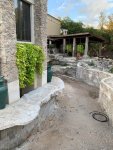As I may have mentioned before, after contracting and supervising all of the initial rock work, patios, landscaping, bar, etc., I decided to go with Build Your Own Pool. And, much to their dismay, I'm going to go for two Pentair IC60's, since it looks like I'll be using Pentair Intellicenter and their 140 filters. BYOP sent out the specs today to various subs to get bids, hopefully I can find one experienced in SWG.
So far the rock we've selected hasn't been softer limestone. Some of the decks further from the pool might be softer but any rock so far that touches the later is very dense, heavy and hard (we know this from the weight, and from cutting, shaping and drilling). And, as cowboycasey suggested, I might go with travertine coping. At this point, just to minimize any possible destruction...I'm thinking that we will seal the rock coping, any rock that's below the water line, the top and bottoms of the rock slabs that form the waterfalls, the swim-up bar, etc., with a clear, semi-gloss epoxy sealer. I've seen this used on a couple of driveways and after a couple of years of weathering and heavy use, you can't tell there's any wear at all. It doesn't leave a slippery surface and only a slightly wet look, which should be fine around a pool. I can get the name if anyone is interested.
I've asked the people I'm dealing with at BYOP to put me in touch with anyone that has had corrosion or damage issues from SWG, but like everyone on here says, it seems to always be "they heard of several people" or "another contractor told them" or one pool builder or another used to use SWG and had issues so stopped"...
Questions:
1) Has anyone used epoxy sealers...good...bad results?
2) I notice the recommendation to use a SWG sized for 2X the volume of the pool. If my pool is 100,000 gal. would two 60,000 size units be sufficient?
3) BYOP has recommended two identical independent systems, which seems like the way to go. I'll wait to see what the bids/recommendations are, but does this sound right?
4) I want to see what the cost of the in-floor cleaning system runs. But I'll also have outlets set up for robots since the electrical outlets are already available (10 ft from pool, etc.). I think I'd need three or 4 outlets. There have been comments that people have had problems with penetrations of the shell with the in-floor systems. I haven't seen or heard about those comments. Is that an issue?




